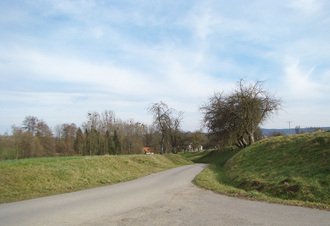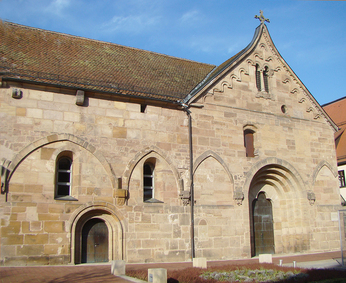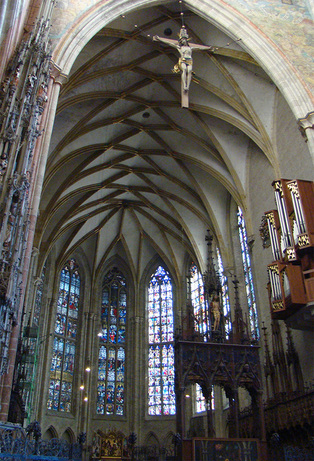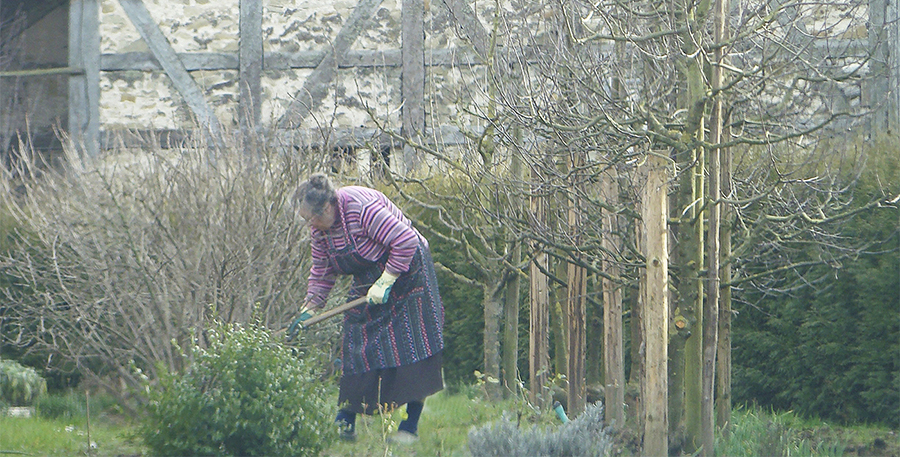For a printable version of newsletter click here.
FARMER IN ARMS
Tracing your roots back in time usually carries the hope that at least some progenitors were productive and positive, fulfilled and fortunate. Farm families would like to envision their long-ago generations in pastoral settings of the Good Old Days when life in the country passed serene, the pace simple and slow compared to our stressed, hectic, confusing 21st century.
Alas, when Lena Lentz Hardt travels from Lentz Spelt Farms on the Columbia Plateau, to follow her family’s narrative in the Germany from where they emigrated to Catherine the Great’s Russia in the 1700s, she encounters her forebears suffering hard times, and worse than hard times more often than not. Once German agriculture had turned permanent around 700 AD, the so-called nobility and the church commanded work without remuneration, they enforced taxes and more taxes, they demanded services related to military affairs, and, worst of all, they often instituted outright serfdom. That’s a whole list of grave injustices piled heavily upon farmers almost continuously. A further sinking feeling Lentz experiences when she contemplates the horrors of the Black Death, and in its aftermath the collective insanity of witch hunts that left the Middle Ages behind to usher in the Modern Era.
Only in few eras and areas did circumstances allow for idyllic rural lives in the 1000-year span, when work was hard but farmers could reap the fruits of their toil fairly enough for their families. Despite the fact that those periods were rather far between, farmers would always hold up their ideal of a rural community with self-determination, the Dorf of free folk.
Why such didn’t materialize with any consistency comes down to class structures modeled on Rome’s civilization that riveted in place social divisions. Pope and king laid claim that God Himself had anointed them; in order for them to remain standing on top, the lower steps of the imposed social ladder had to be kept firmly in place by any means no matter how brutal.
Not that this is how history is taught. Old-school history books stand behind aristocracy and the upper echelon of established clergy; to this day European attractions sucker tourists to applaud how Duke So-von-So built this grand castle, how Bishop Such-and-Such adorned that cathedral, and weren’t they fine men.
In sum we’re presented with a skewed view of a past that in actuality consisted mostly of merciless suppression by those whom historians put in the limelight. For the vast majority of us, neither king’s court nor cathedral but farm villages were our forebears’ world if you go back far enough.
One could at this point ask why history was and is taught from the prism of the high and mighty, but that’s rather obvious, isn’t it, just look at who pays the teachers’ salaries. Government and established church always bolster their authority with historical slant.
Nevertheless, in the 1970s new voices begin to give rise to another version of the past. The facts are not much different, but the perspective is: this crop of historians research the view not from the top down but from the bottom up. And so we have many a case where a mere footnote in old-school teachings becomes the historically more important event of an age indeed.
Nowhere is this more pronounced than when the Lentz timeline gets to the first half of the 1500s. History buffs will guess that here comes the Renaissance. And so it does, albeit the Renaissance is but a turn of philosophical, artistic, and scientific mind-set. Without question the zeitgeist changed, yet bigger changes were afoot on other levels. Next guess: the Reformation, Martin Luther and the Kaiser, all that religiously political and military upheaval leading into the Thirty-Year War a century later. The Reformation’s footnote would be the German Peasants War, but when you invert the old-school perspective, the Reformation as it played out was not the driver but the indirect result of a valiant farmer and peasant revolution. As we shall see.
Tracing your roots back in time usually carries the hope that at least some progenitors were productive and positive, fulfilled and fortunate. Farm families would like to envision their long-ago generations in pastoral settings of the Good Old Days when life in the country passed serene, the pace simple and slow compared to our stressed, hectic, confusing 21st century.
Alas, when Lena Lentz Hardt travels from Lentz Spelt Farms on the Columbia Plateau, to follow her family’s narrative in the Germany from where they emigrated to Catherine the Great’s Russia in the 1700s, she encounters her forebears suffering hard times, and worse than hard times more often than not. Once German agriculture had turned permanent around 700 AD, the so-called nobility and the church commanded work without remuneration, they enforced taxes and more taxes, they demanded services related to military affairs, and, worst of all, they often instituted outright serfdom. That’s a whole list of grave injustices piled heavily upon farmers almost continuously. A further sinking feeling Lentz experiences when she contemplates the horrors of the Black Death, and in its aftermath the collective insanity of witch hunts that left the Middle Ages behind to usher in the Modern Era.
Only in few eras and areas did circumstances allow for idyllic rural lives in the 1000-year span, when work was hard but farmers could reap the fruits of their toil fairly enough for their families. Despite the fact that those periods were rather far between, farmers would always hold up their ideal of a rural community with self-determination, the Dorf of free folk.
Why such didn’t materialize with any consistency comes down to class structures modeled on Rome’s civilization that riveted in place social divisions. Pope and king laid claim that God Himself had anointed them; in order for them to remain standing on top, the lower steps of the imposed social ladder had to be kept firmly in place by any means no matter how brutal.
Not that this is how history is taught. Old-school history books stand behind aristocracy and the upper echelon of established clergy; to this day European attractions sucker tourists to applaud how Duke So-von-So built this grand castle, how Bishop Such-and-Such adorned that cathedral, and weren’t they fine men.
In sum we’re presented with a skewed view of a past that in actuality consisted mostly of merciless suppression by those whom historians put in the limelight. For the vast majority of us, neither king’s court nor cathedral but farm villages were our forebears’ world if you go back far enough.
One could at this point ask why history was and is taught from the prism of the high and mighty, but that’s rather obvious, isn’t it, just look at who pays the teachers’ salaries. Government and established church always bolster their authority with historical slant.
Nevertheless, in the 1970s new voices begin to give rise to another version of the past. The facts are not much different, but the perspective is: this crop of historians research the view not from the top down but from the bottom up. And so we have many a case where a mere footnote in old-school teachings becomes the historically more important event of an age indeed.
Nowhere is this more pronounced than when the Lentz timeline gets to the first half of the 1500s. History buffs will guess that here comes the Renaissance. And so it does, albeit the Renaissance is but a turn of philosophical, artistic, and scientific mind-set. Without question the zeitgeist changed, yet bigger changes were afoot on other levels. Next guess: the Reformation, Martin Luther and the Kaiser, all that religiously political and military upheaval leading into the Thirty-Year War a century later. The Reformation’s footnote would be the German Peasants War, but when you invert the old-school perspective, the Reformation as it played out was not the driver but the indirect result of a valiant farmer and peasant revolution. As we shall see.
*****
A Swiss professor, Peter Blickle of Bern, is now recognized as the most impeccable researcher in discussing the 1500s events pivotal for farmers in Central Europe. On Lentz’s genealogy chart, every single birthplace that’s recorded in Germany falls into one of the regions where farmers rose up in a revolution that would stand as the largest European class war until the French Revolution of 1789, according to Blickle. Whereas there is no telling if Lentz’s forebears took up arms against their suppressors, odds are that at least some of them did, seeing how Weinsbach by Öhringen, in the Kreis Hohenlohe (Lentz’s Hauser branch of forebears’ home) lies close to Heilbronn which was a flash point in the farmers’ struggle. In contemplating the enormous uprising of 1524-1525, Lentz sees the old lanes between fields and the back-road approaches to the Dorf take on a different tinge. She pauses on our walk, lets her camera dangle, tilts her head – are those sounds on the wind a farmers’ army marching?

Conventional historians call it Deutscher Bauernkrieg (German Peasants War) which is wrong-headed because, so Blickle points out, these events were neither “German” since French and Slavic regions also participated, nor was it an uprising of only “peasants” because miners and also the burghers of some cities joined, and, it was a revolution rather than a war: “The revolution of the common people,” so Blickle demonstrates in his Die Revolution von 1525, © 1975.
Blickle compiles excruciating detail of that fateful year, excruciating in quotes from many scores of documents written in various dialects, which makes the reading extremely cumbersome; even someone fluent in German stumbles over the old verbiage and convoluted grammar (not until Konrad Duden’s Wörterbuch in the 1880s did German become a somewhat uniform language with uniform spelling). Fortunately, by 1981 two American professors, Thomas Brady Jr. of the University of Oregon and Erik Midelfort of the University of Virginia, published an English version: The Revolution of 1525, The German Peasants’ War from a New Perspective. Their work ranks more than mere translation: “Blickle’s scrupulous citation of manuscript... is so voluminous” that Brady and Midelfort edited, ultimately presenting a readable account.
But even at that, the complexities of the events, and of all that led up to them, are stunning.
The professors introduce their topic with a historiography with widely diverging analyses of the 1525 uprisings, ranging from communist exposition – Friedrich Engels declared it “the grandest revolutionary effort of the German people” –, to theological analysis of revolutionary connections to the Anabaptists.
Two earlier developments made the 1525 Revolution’s orbit possible: the introduction of paper making from China, with the first German water-powered paper mills operating in 13th century, and, the invention of movable-type printing in the mid-1400s at Mainz. Being able to print at reasonable cost meant that publishing got into swing; literacy spread. In our context, it defined the communication that would result in farmers attacking their suppressors, specifically a manifesto consisting of Twelve Articles of which over 25,000 copies were distributed across large regions in just two months. Thus masses of people read, or were being read to, identical text; there was no bending of meaning as you’d have if messages were passing mouth-to-mouth.
“Without the Twelve Articles the Peasants’ War would have been very different,” Blickle asserts.
Yes, for the first time in our time-travel we read not only accounts about farmers, but words farmers penned themselves. The Twelve Articles, in addition to listing grievances and demands from Swabia, call for a program for change.
Blickle compiles excruciating detail of that fateful year, excruciating in quotes from many scores of documents written in various dialects, which makes the reading extremely cumbersome; even someone fluent in German stumbles over the old verbiage and convoluted grammar (not until Konrad Duden’s Wörterbuch in the 1880s did German become a somewhat uniform language with uniform spelling). Fortunately, by 1981 two American professors, Thomas Brady Jr. of the University of Oregon and Erik Midelfort of the University of Virginia, published an English version: The Revolution of 1525, The German Peasants’ War from a New Perspective. Their work ranks more than mere translation: “Blickle’s scrupulous citation of manuscript... is so voluminous” that Brady and Midelfort edited, ultimately presenting a readable account.
But even at that, the complexities of the events, and of all that led up to them, are stunning.
The professors introduce their topic with a historiography with widely diverging analyses of the 1525 uprisings, ranging from communist exposition – Friedrich Engels declared it “the grandest revolutionary effort of the German people” –, to theological analysis of revolutionary connections to the Anabaptists.
Two earlier developments made the 1525 Revolution’s orbit possible: the introduction of paper making from China, with the first German water-powered paper mills operating in 13th century, and, the invention of movable-type printing in the mid-1400s at Mainz. Being able to print at reasonable cost meant that publishing got into swing; literacy spread. In our context, it defined the communication that would result in farmers attacking their suppressors, specifically a manifesto consisting of Twelve Articles of which over 25,000 copies were distributed across large regions in just two months. Thus masses of people read, or were being read to, identical text; there was no bending of meaning as you’d have if messages were passing mouth-to-mouth.
“Without the Twelve Articles the Peasants’ War would have been very different,” Blickle asserts.
Yes, for the first time in our time-travel we read not only accounts about farmers, but words farmers penned themselves. The Twelve Articles, in addition to listing grievances and demands from Swabia, call for a program for change.

Having foreknowledge that “the common people” will lose in the end, today one can dissect reasons for their defeat. A crucial weakness of the Twelve Articles that were sworn to across a huge swath of land, was that they stopped short of abolishing pope and king (although a few of the more radical voices did call for just that). By leaving in place royal and papal authority, and thereby the laws that aristocracy formulated plus canon law, the farmers needed to find a legal foundation to justify political change. It is at this juncture that religious tones enter the program – could legal arguments for social justice be based on the Bible?
*****
Farmer uprisings had erupted for centuries in many localities. That changed in the mid-1400s when farmers banded together in rebellion that spread beyond strictly local, such as the regional movement whose symbol was the Bundschuh. (As previously noted: the Bundschuh was the sturdy boot worn by farmers; Franz Kurowski traces the beginnings of the Bundschuh symbolism to 1443 in the Dorf Schliengen near Basel, stating that the farmer rebels put forth “demands... for a ‘godly right’... with radical and revolutionary theses... which shocked the authorities by insistence on natural equality and the triumph of the poor.”)
Eight decades later the farmer associations – Landschaften – had grown considerably in their reach, and after several Landschaften had formed a loose federation, their leaders approached a number of religious reformers, Blickle writes.
Reformation had been brewing for almost four centuries. Again and again religious dissidents started movements that defined Christian thought differently than the church did. By the time Halloween came around in 1517, which is when Martin Luther nailed his 95 Theses on the church door in the Saxon town of Wittenberg, hundreds of monks and scholars in German lands preached against the papacy in Rome. The roots of the “communal Reformation” (which marks the ideology of the peasant insurrection) reach “far back into the 15th century,” Brady and Midelfort write in their introduction to Blickle’s work.
The Reformation leaders the farmers addressed were Huldrych Zwingli, Martin Luther, Philip Melanchthon, Andreas Osiander, Conrad Billican, Mathew Zell, and “a series of others whom the peasants knew not by name but only by office and place of residence.”
The farmers’ request fell on deaf ears. They were especially disappointed that Zwingli gave them no support, despite the fact that in his Sixty-Seven Conclusions he’d spelled out that worldly law should be brought into accord with “godly” law.
It seems that the torchbearers of the Reformation trends had big egos, each wanting his own bible interpretation to win out in the end. Blickle describes the intellectual struggle between Luther and Zwingli thus: “Luther’s christology was one of Christmas while Zwingli’s was one of Easter or Ascension.”
Enter Thomas Müntzer. In this theologian the farmers finally had a supporter who championed their demands. More: Müntzer would become the leader of one of the revolutionaries’ armies. Zwingli cautioned the princes to adapt their law-making to “natural” or “godly” law – “otherwise... there will be unrest.” In contrast, Müntzer actually threatened the princes: “Everyone should properly receive according to his need. Any prince, count or lord who refuses to do this even when seriously warned should be hanged or have his head chopped off.” Müntzer used his Christian League that had grown strong since 1520-1521, as “organization or institutional framework,” Blickle notes.
Blickle defines three main Reformation streams in 1525: Luther’s Wittenberg theology that stood for the princes; Zwingli’s “Christian humanists;” and Müntzer’s “theologians of the Spirit” from whose ranks the Anabaptists and Spiritualists would come. “Müntzer was fighting for a world of the last days according to God’s plan of salvation,” Blickle puts it.
Eight decades later the farmer associations – Landschaften – had grown considerably in their reach, and after several Landschaften had formed a loose federation, their leaders approached a number of religious reformers, Blickle writes.
Reformation had been brewing for almost four centuries. Again and again religious dissidents started movements that defined Christian thought differently than the church did. By the time Halloween came around in 1517, which is when Martin Luther nailed his 95 Theses on the church door in the Saxon town of Wittenberg, hundreds of monks and scholars in German lands preached against the papacy in Rome. The roots of the “communal Reformation” (which marks the ideology of the peasant insurrection) reach “far back into the 15th century,” Brady and Midelfort write in their introduction to Blickle’s work.
The Reformation leaders the farmers addressed were Huldrych Zwingli, Martin Luther, Philip Melanchthon, Andreas Osiander, Conrad Billican, Mathew Zell, and “a series of others whom the peasants knew not by name but only by office and place of residence.”
The farmers’ request fell on deaf ears. They were especially disappointed that Zwingli gave them no support, despite the fact that in his Sixty-Seven Conclusions he’d spelled out that worldly law should be brought into accord with “godly” law.
It seems that the torchbearers of the Reformation trends had big egos, each wanting his own bible interpretation to win out in the end. Blickle describes the intellectual struggle between Luther and Zwingli thus: “Luther’s christology was one of Christmas while Zwingli’s was one of Easter or Ascension.”
Enter Thomas Müntzer. In this theologian the farmers finally had a supporter who championed their demands. More: Müntzer would become the leader of one of the revolutionaries’ armies. Zwingli cautioned the princes to adapt their law-making to “natural” or “godly” law – “otherwise... there will be unrest.” In contrast, Müntzer actually threatened the princes: “Everyone should properly receive according to his need. Any prince, count or lord who refuses to do this even when seriously warned should be hanged or have his head chopped off.” Müntzer used his Christian League that had grown strong since 1520-1521, as “organization or institutional framework,” Blickle notes.
Blickle defines three main Reformation streams in 1525: Luther’s Wittenberg theology that stood for the princes; Zwingli’s “Christian humanists;” and Müntzer’s “theologians of the Spirit” from whose ranks the Anabaptists and Spiritualists would come. “Müntzer was fighting for a world of the last days according to God’s plan of salvation,” Blickle puts it.

Martin Luther makes his stand perfectly clear in May 1525, as quoted in Franken by Franz Kurowski: “Dear Lords, stab, cudgel, choke (who) you can!,” Luther wrote. “If you die because of this, good for you! A holier death you’ll never meet. Because you die in obedience to godly order. The ruling class shall in good conscience strike (farmers) down, as long as an artery moves. Because the farmers (have) evil conscience and (do) lawless things, and the farmer who is killed, his body and soul lost, forever belongs to the devil.”
That’s Luther for you. Kurowski writes that Luther’s hatred of farmers stems from the ire he felt for Müntzer. Opportunistically, Luther stood by the aristocrats because, “only from them could he expect protection for his (version of) church renewal,” Kurowski points out.
For all of Luther’s anger, the revolutionists’ Twelve Articles do express piety. “The Just and Fundamental Articles of All Peasantry and Tenants of Spiritual and Temporal Powers by Whom They Think Themselves Oppressed,” runs the prologue.
The demands in a nutshell:
1) The parishes to elect their own pastors.
2) Restoration of the tithe to the community.
3) Abolishment of Leibeigene serfdom.
4) Rights to fish and hunt.
5) Forests to be returned to the villages’ commons.
6) Reductions in Fronarbeit service and labor.
7) Proper payment for services.
8) Reassessment of dues on tenant lands.
9) Roll-back of fines.
10) Restoration of meadows and fields to the commons.
11) Refusal of servile death taxes.
12) To harmonize the secular order with the Word of God.
Blickle puts great emphasis on the fact that the connection between Reformation and revolution did not make for strong legitimation. He demonstrates this with a sociological equation – Readiness to Revolt, equals: Economic Burden plus Social Tension plus Political Expectations, divided by Strength of Legitimation. “The weaker the force of legitimation, the greater the readiness to revolt.”
And the revolt when it came was certainly explosive. “The hallmark of the revolts in the first two months of 1525 was the supraterritorial character. Peasants from widely different lordships came together..., never before had peasant revolts broken through the narrow political boundaries,” Blickle points out.
The spark that set off the powder keg in 1524 was a woman’s preposterous demand, according to several chronicles. (This from the German version:) She was the wife of Count von Lupfen in the Upper Rhine region. The count’s farmers were in the middle of harvest. If you’ve experienced wheat harvest today, with its hectic undercurrent – cutting all those many acres, always apprehensive of disruptive mechanical failures or adverse weather –, you can imagine how frantic harvest must have been in the 1500s, all that hard manual labor in the dusty heat, every able-bodied villager out in the fields, grave worry that lightning might strike from the cumulonimbus clouds typical in the German summers. Well, in the middle of this harvest toil, the countess insists on having the farmers do Fronarbeit, their compulsory service without pay. In particular she wants everyone to collect snail shells, right now. She needs the shells for winding her yarn around, you see. The next day, June 23, “the farmers answered this outrageous command by organizing their resistance. Military leaders were appointed, they put up a small flag, and Hans Müller of Bulgenbach was elected leader,” Blickle writes.
That’s Luther for you. Kurowski writes that Luther’s hatred of farmers stems from the ire he felt for Müntzer. Opportunistically, Luther stood by the aristocrats because, “only from them could he expect protection for his (version of) church renewal,” Kurowski points out.
For all of Luther’s anger, the revolutionists’ Twelve Articles do express piety. “The Just and Fundamental Articles of All Peasantry and Tenants of Spiritual and Temporal Powers by Whom They Think Themselves Oppressed,” runs the prologue.
The demands in a nutshell:
1) The parishes to elect their own pastors.
2) Restoration of the tithe to the community.
3) Abolishment of Leibeigene serfdom.
4) Rights to fish and hunt.
5) Forests to be returned to the villages’ commons.
6) Reductions in Fronarbeit service and labor.
7) Proper payment for services.
8) Reassessment of dues on tenant lands.
9) Roll-back of fines.
10) Restoration of meadows and fields to the commons.
11) Refusal of servile death taxes.
12) To harmonize the secular order with the Word of God.
Blickle puts great emphasis on the fact that the connection between Reformation and revolution did not make for strong legitimation. He demonstrates this with a sociological equation – Readiness to Revolt, equals: Economic Burden plus Social Tension plus Political Expectations, divided by Strength of Legitimation. “The weaker the force of legitimation, the greater the readiness to revolt.”
And the revolt when it came was certainly explosive. “The hallmark of the revolts in the first two months of 1525 was the supraterritorial character. Peasants from widely different lordships came together..., never before had peasant revolts broken through the narrow political boundaries,” Blickle points out.
The spark that set off the powder keg in 1524 was a woman’s preposterous demand, according to several chronicles. (This from the German version:) She was the wife of Count von Lupfen in the Upper Rhine region. The count’s farmers were in the middle of harvest. If you’ve experienced wheat harvest today, with its hectic undercurrent – cutting all those many acres, always apprehensive of disruptive mechanical failures or adverse weather –, you can imagine how frantic harvest must have been in the 1500s, all that hard manual labor in the dusty heat, every able-bodied villager out in the fields, grave worry that lightning might strike from the cumulonimbus clouds typical in the German summers. Well, in the middle of this harvest toil, the countess insists on having the farmers do Fronarbeit, their compulsory service without pay. In particular she wants everyone to collect snail shells, right now. She needs the shells for winding her yarn around, you see. The next day, June 23, “the farmers answered this outrageous command by organizing their resistance. Military leaders were appointed, they put up a small flag, and Hans Müller of Bulgenbach was elected leader,” Blickle writes.
*****
If this last-straw incident is readily pictured, the fact that it led to a conflagration that engulfed the better part of central Europe points to a major underlying malaise.
Blickle explains that after the worst effects of the Black Death had subsided, the population curve pointed upwards again – between 1496 and 1542 population increases by as much as 69 percent are on record. The scattered possessions of many feudal lords did not bring in enough venue, partly because the agrarian economy lagged, partly because a diversification of economy was happening outside the agrarian sector; and now, too, villages had so many more mouths to feed.
The princes saw this as opportunity to “territorialize,” that is, they formed contiguous territories that they would govern as states. Instead of being a tenant on land of an aristocrat who ruled over splintered land tracts – small scattered properties –, farmers and peasants were coming under the control of an organized government of small states and large states: “Territories like the prince-abbey of Kempten are small states, while those like Tyrol are large states.”
The shift from feudalism to territorial state was – you guessed it – devastating for farmers. Unlike slaves, serfs couldn’t be sold, so they were traded by the thousands as the high aristocracy haggled with one another over the borders within which they would govern.
Whereas feudal counts had left rural villages to their own devices when it came to local matters and justice, now the princes placed their own officers directly inside the villages, to administer law and collect excise, territorial, and military taxes. These officers came from lower nobility and the emerging bourgeoisie. Blickle estimates that peasants paid half their annual incomes in taxes and dues, and now also had to provide food for all those wardens and bureaucrats in their midst.
This is the era when prison was invented, and policing became the order of the day, especially on forest lands that had formerly been village commons. The penalty for poaching, Blickle notes, “could be so severe that a peasant who killed a stag in his own fields was sewn into the stag’s skin and torn into pieces by the hounds.”
To mold their subjects more equal among themselves – speak: make them better governable –, princes and bishops enacted policies such as severe levels of death tax that turned an ever higher percentage of farmers into Leibeigene serfs. “There was almost nothing so firmly engraved in the peasant mentality as the idea of original freedom, even though successful efforts to make everyone equal finally only turned all peasants into serfs,” Blickle comments.
The monasteries, meanwhile, out-paced the princes in crushing farmers and peasants. “Monastic villages attacked the high level of rents, restrictions on marriage, the demand for death taxes, and similar acts acknowledging servile status and did so much more vociferously... The clergy became the main target of the revolutionary movement...”
Another facet of farmer discontent was the trend to fewer tenant farms as more land was put under management that got the work done with day-laborers. This shift put further stress on villages, Blickle writes.
Lastly, mobility had been curbed drastically. The peasant exodus to town and city, so freely and prevalent after the Black Death population decline, had come to a stop; by 1500, villagers were forced to stay put, and only occasionally an individual managed to get away.
The farmers reacted to the transition to territorial state with the aforementioned Landschaften – “associative institutions, corporations of the entire territory, partly allied with the old estates in opposition to the territorial prince.”
Prince and bishop of course tried to prevent farmers forming Landschaften. “The story of the formation of the territorial assembly was thus often a story of imprisonment, flight, and banishment. [S]tubborn peasants risked... their very lives to keep from becoming mere pawns of the territorial state,” Blickle reports.
In some cases the Landschaften were able to achieve goals such as repeal of tax increases. In other cases the prince or prince-prior resorted to asking other princes for help in putting down revolts.
In any case, by organizing Landschaften, “the ‘common man’ had become politicized,” Blickle emphasizes.
Blickle explains that after the worst effects of the Black Death had subsided, the population curve pointed upwards again – between 1496 and 1542 population increases by as much as 69 percent are on record. The scattered possessions of many feudal lords did not bring in enough venue, partly because the agrarian economy lagged, partly because a diversification of economy was happening outside the agrarian sector; and now, too, villages had so many more mouths to feed.
The princes saw this as opportunity to “territorialize,” that is, they formed contiguous territories that they would govern as states. Instead of being a tenant on land of an aristocrat who ruled over splintered land tracts – small scattered properties –, farmers and peasants were coming under the control of an organized government of small states and large states: “Territories like the prince-abbey of Kempten are small states, while those like Tyrol are large states.”
The shift from feudalism to territorial state was – you guessed it – devastating for farmers. Unlike slaves, serfs couldn’t be sold, so they were traded by the thousands as the high aristocracy haggled with one another over the borders within which they would govern.
Whereas feudal counts had left rural villages to their own devices when it came to local matters and justice, now the princes placed their own officers directly inside the villages, to administer law and collect excise, territorial, and military taxes. These officers came from lower nobility and the emerging bourgeoisie. Blickle estimates that peasants paid half their annual incomes in taxes and dues, and now also had to provide food for all those wardens and bureaucrats in their midst.
This is the era when prison was invented, and policing became the order of the day, especially on forest lands that had formerly been village commons. The penalty for poaching, Blickle notes, “could be so severe that a peasant who killed a stag in his own fields was sewn into the stag’s skin and torn into pieces by the hounds.”
To mold their subjects more equal among themselves – speak: make them better governable –, princes and bishops enacted policies such as severe levels of death tax that turned an ever higher percentage of farmers into Leibeigene serfs. “There was almost nothing so firmly engraved in the peasant mentality as the idea of original freedom, even though successful efforts to make everyone equal finally only turned all peasants into serfs,” Blickle comments.
The monasteries, meanwhile, out-paced the princes in crushing farmers and peasants. “Monastic villages attacked the high level of rents, restrictions on marriage, the demand for death taxes, and similar acts acknowledging servile status and did so much more vociferously... The clergy became the main target of the revolutionary movement...”
Another facet of farmer discontent was the trend to fewer tenant farms as more land was put under management that got the work done with day-laborers. This shift put further stress on villages, Blickle writes.
Lastly, mobility had been curbed drastically. The peasant exodus to town and city, so freely and prevalent after the Black Death population decline, had come to a stop; by 1500, villagers were forced to stay put, and only occasionally an individual managed to get away.
The farmers reacted to the transition to territorial state with the aforementioned Landschaften – “associative institutions, corporations of the entire territory, partly allied with the old estates in opposition to the territorial prince.”
Prince and bishop of course tried to prevent farmers forming Landschaften. “The story of the formation of the territorial assembly was thus often a story of imprisonment, flight, and banishment. [S]tubborn peasants risked... their very lives to keep from becoming mere pawns of the territorial state,” Blickle reports.
In some cases the Landschaften were able to achieve goals such as repeal of tax increases. In other cases the prince or prince-prior resorted to asking other princes for help in putting down revolts.
In any case, by organizing Landschaften, “the ‘common man’ had become politicized,” Blickle emphasizes.
*****
With the exception of Bavaria, all of southern Germany was embroiled in the revolution by 1525, as well as large parts of Austria and Switzerland. Thuringia and parts of Bohemia joined the fray, and the lands along the Rhine up to north of Mainz. Peasant armies of as many as 15,000 marched for Fryheit (Freiheit: “Freedom”); they were referred to as Haufen (literally: “heaps;” “bunches”), every region sending its own Haufen to give chase to prince and count, abbot and bishop.
The peak months of the revolution saw a human foment, farmers, peasants, miners, townsmen on the march. Estimates run to over 100,000 common folk soldiering at one time in the various Haufen, but the overall numbers run considerably higher because the farmers rotated in-and-out of their armies, each returning to their village when another farmer arrived to take his soldier place for two weeks or a month.
The peak months of the revolution saw a human foment, farmers, peasants, miners, townsmen on the march. Estimates run to over 100,000 common folk soldiering at one time in the various Haufen, but the overall numbers run considerably higher because the farmers rotated in-and-out of their armies, each returning to their village when another farmer arrived to take his soldier place for two weeks or a month.

The Haufen weren’t as pitchfork-raggedy as one might imagine. “[T]he rebel infantry was often decently armed with swords, poled weapons, and farm implements... The rebel armies also had guns, quite a few of them... (although) they were woefully short of wall-breaking siege guns,” Brady and Midelfort write, noting that the cannon were obtained from willing, and from not-so-willing, cities. Albeit the revolutionary army had a shortage of experienced gunners.
According to Franz Kurowski (in Franken), in Franconia the Schwarze Haufen did battle, as well as the Tauber Haufen; from the west the Oderwälder Haufen of 6000 came to storm Weinsberg near Heilbronn, a much-talked-about victory for the peasants. After they’d killed the Count of Helfenstein and his entourage of 15 nobles, they paraded the countess through town on a manure wagon. This shocked the aristocracy more than the killings, because this countess was a daughter of a former Kaiser, an aunt of the current Kaiser.
After Weinsberg they pillaged Heilbronn. And then the Haufen stormed and burned several castles of the Deutsche Orden (the Teutonic Knights of Crusades fame). “This goes to show that the Deutsche Orden especially was decried as oppressor and tormentor of farmers,” Kurowski notes.
The Tauber Haufen was joined by citizens of Rothenburg and Würzburg. Their early victories drove the farmers on – they could actually win this thing. They had nobles and clergy on the run: in the bishopric of Bamberg alone, the Haufen destroyed over 150 abbeys and castles.
In mid-May 1525 we see the revolution approach its high point, as the leaders of several Haufen fighting in and near Franconia are summoned to Heilbronn. A new constitution was to be created by a “Peasant Parliament” under leadership of Friedrich Weigandt of Mainz, and Wendel Hipler. “Heilbronn... was the closest thing to a capital the revolution ever had,” comments Blickle.
The above-mentioned Wendel Hipler connects the revolution squarely with the Hauser-branch of the Lentzes: Hipler was the former chancellor of the counts of Hohenlohe, in which district Lentz visited the Dorf Weinsbach. Surely her Hausers would have known Hipler in his chancellor capacity. Likely some of them knew him, too, as revolutionary leader.
According to Franz Kurowski (in Franken), in Franconia the Schwarze Haufen did battle, as well as the Tauber Haufen; from the west the Oderwälder Haufen of 6000 came to storm Weinsberg near Heilbronn, a much-talked-about victory for the peasants. After they’d killed the Count of Helfenstein and his entourage of 15 nobles, they paraded the countess through town on a manure wagon. This shocked the aristocracy more than the killings, because this countess was a daughter of a former Kaiser, an aunt of the current Kaiser.
After Weinsberg they pillaged Heilbronn. And then the Haufen stormed and burned several castles of the Deutsche Orden (the Teutonic Knights of Crusades fame). “This goes to show that the Deutsche Orden especially was decried as oppressor and tormentor of farmers,” Kurowski notes.
The Tauber Haufen was joined by citizens of Rothenburg and Würzburg. Their early victories drove the farmers on – they could actually win this thing. They had nobles and clergy on the run: in the bishopric of Bamberg alone, the Haufen destroyed over 150 abbeys and castles.
In mid-May 1525 we see the revolution approach its high point, as the leaders of several Haufen fighting in and near Franconia are summoned to Heilbronn. A new constitution was to be created by a “Peasant Parliament” under leadership of Friedrich Weigandt of Mainz, and Wendel Hipler. “Heilbronn... was the closest thing to a capital the revolution ever had,” comments Blickle.
The above-mentioned Wendel Hipler connects the revolution squarely with the Hauser-branch of the Lentzes: Hipler was the former chancellor of the counts of Hohenlohe, in which district Lentz visited the Dorf Weinsbach. Surely her Hausers would have known Hipler in his chancellor capacity. Likely some of them knew him, too, as revolutionary leader.

Had all the Haufen come together in one grand army of over 100,000, who knows how things would have turned out. A people’s revolution fighting to success would surely have resulted in a very different history, 250 years before the American Revolutionary War against aristocracy.
But the Haufen continued fighting separately, partly because the leaders hadn’t mastered military logistics; even basics, such as feeding the separate armies, pitched them into difficulty.
If the revolutionary armies “had some real successes against the nobles,” toward the end they were defeated in battles after only a short fight. The Swabian League’s formidable force of mostly mercenaries in the employ of princes, joined forces with various other princes‘ armies. “War had become a business of professionals, and untrained bands could rarely expect to hold the day against professional soldiers,” Brady and Midelfort conclude.
But the Haufen continued fighting separately, partly because the leaders hadn’t mastered military logistics; even basics, such as feeding the separate armies, pitched them into difficulty.
If the revolutionary armies “had some real successes against the nobles,” toward the end they were defeated in battles after only a short fight. The Swabian League’s formidable force of mostly mercenaries in the employ of princes, joined forces with various other princes‘ armies. “War had become a business of professionals, and untrained bands could rarely expect to hold the day against professional soldiers,” Brady and Midelfort conclude.
*****
In the wake of the failed revolution, massacres. Having returned to their seats of power, princes and bishops had villages burned by the hundreds; farmers and peasants were slaughtered by the thousands, beheaded, hanged, or burned at the stake. Over 100,000 farmers and peasants were murdered on nobles’ and bishops’ orders in a very short period.
What did the 1525 Revolution achieve? A few constitutional concessions were granted in some territorial states, but in general the princes and bishops used their military victory to consolidate their control over the common people, and oppress them more than ever in their territorial states of police and prisons. They’d arrived at a new strategy, “to entangle subjects in a complex administrative and legal system, thereby cutting rebellion at the root, making it impossible as the last resort of social behavior.” That this didn’t completely succeed is the story of numerous revolts that followed in the 17th and 18th centuries, Blickle remarks.
What did the 1525 Revolution achieve? A few constitutional concessions were granted in some territorial states, but in general the princes and bishops used their military victory to consolidate their control over the common people, and oppress them more than ever in their territorial states of police and prisons. They’d arrived at a new strategy, “to entangle subjects in a complex administrative and legal system, thereby cutting rebellion at the root, making it impossible as the last resort of social behavior.” That this didn’t completely succeed is the story of numerous revolts that followed in the 17th and 18th centuries, Blickle remarks.

As for the Reformation: “With the help of theologians, the rulers tried to restore their own legitimacy by turning the gospel squarely against the common man,” Blickle emphasizes; in this way Reformation dissolved into Protestantism, a state religion just as Luther had wanted it. “The communal Reformation and the rulers‘ Reformation could not be made compatible... The proof of this is a glance at the history of the Anabaptists. They sought to save a remnant of the communal Reformation by withdrawing from the realm of this world; but the rulers mercilessly exterminated them.”
But the rulers couldn’t stop the Anabaptists’ spiritual heritage from resurfacing in the communal and pacifist Christianity of the Amish, the Hutterites, the Mennonites. Once again we remember the words of Pastor Klose during Lentz’s tour of the monastery at Heilsbronn: “In every emigration wave out of Germany, the first to leave were always the Pacifists.”
To think that a great revolution lingers early in their background...
Lentz in Weinsbach: shocked, saddened, appalled, wondering if from the centuries-old beeches at the edge of the Dorf once dangled some of her relatives.
Back in town, Öhringen, we find an afternoon-quiet bakery near the market square. Lentz chooses a few simple Plätzchen – cookies – and sips her espresso thoughtfully.
© 2014 Lentz Spelt Farms
But the rulers couldn’t stop the Anabaptists’ spiritual heritage from resurfacing in the communal and pacifist Christianity of the Amish, the Hutterites, the Mennonites. Once again we remember the words of Pastor Klose during Lentz’s tour of the monastery at Heilsbronn: “In every emigration wave out of Germany, the first to leave were always the Pacifists.”
To think that a great revolution lingers early in their background...
Lentz in Weinsbach: shocked, saddened, appalled, wondering if from the centuries-old beeches at the edge of the Dorf once dangled some of her relatives.
Back in town, Öhringen, we find an afternoon-quiet bakery near the market square. Lentz chooses a few simple Plätzchen – cookies – and sips her espresso thoughtfully.
© 2014 Lentz Spelt Farms



 RSS Feed
RSS Feed